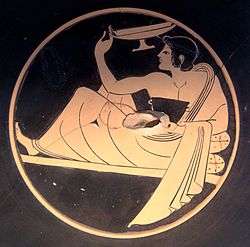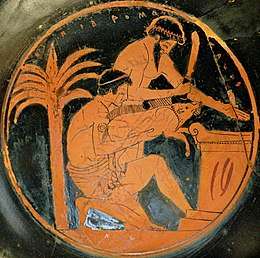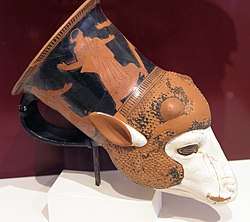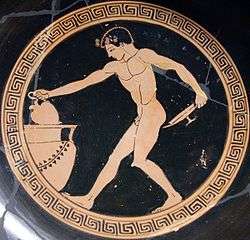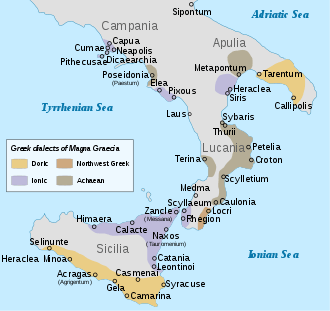Ancient Greek cuisine
Ancient Greek cuisine was characterized by its frugality for most, reflecting agricultural hardship, but a great diversity of ingredients was known, and wealthy Greeks were known to celebrate with elaborate meals and feasts.[1]:95(129c) The cuisine was founded on the "Mediterranean triad" of cereals, olives, and grapes,[2] which had many uses and great commercial value, but other ingredients were as important, if not more so, to the average diet: most notably legumes. Research suggests that the agricultural system of Ancient Greece could not have succeeded without the cultivation of legumes.[3]
Modern knowledge of ancient Greek cuisine and eating habits is derived from textual, archeological, and artistic evidence.
Meals
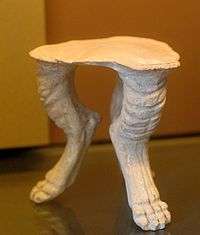
At home
The Greeks had three to four meals a day. Breakfast (ἀκρατισμός akratismós) consisted of barley bread dipped in wine (ἄκρατος ákratos), sometimes complemented by figs or olives.[4] They also ate pancakes called τηγανίτης (tēganítēs), ταγηνίτης(tagēnítēs)[5] or ταγηνίας (tagēnías),[6] all words deriving from τάγηνον (tágēnon), "frying pan".[7] The earliest attested references on tagenias are in the works of the 5th century BC poets Cratinus[8] and Magnes.[9]
Tagenites were made with wheat flour, olive oil, honey and curdled milk, and were served for breakfast.[10][11][12] Another kind of pancake was σταιτίτης (staititēs), from σταίτινος (staitinos), "of flour or dough of spelt",[13] derived from σταῖς (stais), "flour of spelt".[14] Athenaeus in his Deipnosophistae mentions staititas topped with honey, sesame and cheese.[15][16][17]
A quick lunch (ἄριστον ariston[18]) was taken around noon or early afternoon.[19] Dinner (δεῖπνον deipnon), the most important meal of the day, was generally taken at nightfall.[19] An additional light meal (ἑσπέρισμα hesperisma) was sometimes taken in the late afternoon.[19] Ἀριστόδειπνον / aristodeipnon, literally "lunch-dinner", was served in the late afternoon instead of dinner.[20]
Men and women took their meals separately.[21] When the house was too small, the men ate first, the women afterwards.[22] Slaves waited at dinners. Aristotle notes that "the poor, having no slaves, would ask their wives or children to serve food." Respect for the father who was the breadwinner was obvious.[23]
The ancient Greek custom of placing terra cotta miniatures of their furniture in children's graves gives us a good idea of its style and design. The Greeks normally ate while seated on chairs; benches were used for banquets.[24] The tables, high for normal meals and low for banquets, were initially rectangular in shape. By the 4th century BC, the usual table was round, often with animal-shaped legs (for example lion's paws). Loaves of flat bread could be used as plates, but terra cotta bowls were more common.[25]
Dishes became more refined over time, and by the Roman period plates were sometimes made out of precious metals or glass. Cutlery was not often used at the table: use of the fork was unknown; people ate with their fingers.[26] Knives were used to cut the meat.[25] Spoons were used for soups and broths.[25] Pieces of bread (ἀπομαγδαλία apomagdalia) could be used to spoon the food[26] or as napkins to wipe the fingers.[27]
Social dining
As with modern dinner parties, the host could simply invite friends or family; but two other forms of social dining were well documented in ancient Greece: the entertainment of the all-male symposium, and the obligatory, regimental syssitia.
Symposium
The symposium (συμπόσιον symposion), traditionally translated as "banquet", but more literally "gathering of drinkers",[28] was one of the preferred pastimes for Greek men. It consisted of two parts: the first dedicated to food, generally rather simple, and a second part dedicated to drinking.[28] However, wine was consumed with the food, and the beverages were accompanied by snacks (τραγήματα tragēmata) such as chestnuts, beans, toasted wheat, or honey cakes, all intended to absorb alcohol and extend the drinking spree.[29]
The second part was inaugurated with a libation, most often in honor of Dionysus,[30] followed by conversation or table games, such as kottabos. The guests would recline on couches (κλίναι klinai); low tables held the food or game boards. Dancers, acrobats, and musicians would entertain the wealthy banqueters. A "king of the banquet" was drawn by lots; he had the task of directing the slaves as to how strong to mix the wine.[30]
With the exception of courtesans, the banquet was strictly reserved for men. It was an essential element of Greek social life. Great feasts could only be afforded by the rich; in most Greek homes, religious feasts or family events were the occasion of more modest banquets. The banquet became the setting of a specific genre of literature, giving birth to Plato's Symposium, Xenophon's work of the same name, the Table Talk of Plutarch's Moralia, and the Deipnosophists (Banquet of the Learned) of Athenaeus.
Syssitia
The syssitia (τὰ συσσίτια ta syssitia) were mandatory meals shared by social or religious groups for men and youths, especially in Crete and Sparta. They were referred to variously as hetairia, pheiditia, or andreia (literally, "belonging to men"). They served as both a kind of aristocratic club and as a military mess. Like the symposium, the syssitia was the exclusive domain of men — although some references have been found to substantiate all-female syssitia. Unlike the symposium, these meals were hallmarked by simplicity and temperance.
Ingredients and dishes
First she set for them a fair and well made table that had feet of cyanus; On it there was a vessel of bronze and an onion to give relish to the drink, with honey and cakes of barley meal.
— Homer, Iliad Book XI[31]
Grains
Breads and cakes
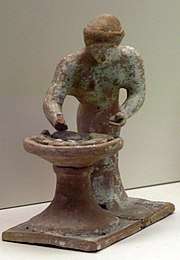
Cereals formed the staple diet. The two main grains were wheat (σῖτος sitos) and barley (κριθή krithe).[32] Pliny the Elder wrote that commercial bakeries arrived in Rome during the Macedonian Wars around 170 BC. Plato favored home production over commercial production and in Gorgias, described Thearion the baker as an Athenian novelty who sells goods that could be made at home.[33]
In ancient Greece, bread was served with accompaniments known as opson ὄψον, sometimes rendered in English as "relish".[34] This was a generic term which referred to anything which accompanied this staple food, whether meat or fish, fruit or vegetable.
Cakes may have been consumed for religious reasons as well as secular. Philoxenus of Cythera describes in detail some cakes that were eaten as part of an elaborate dinner using the traditional dithyrambic style used for sacred Dionysian hymns: "mixed with safflower, toasted, wheat-oat-white-chickpea-little thistle-little-sesame-honey-mouthful of everything, with a honey rim". Athenaeus says the charisios was eaten at the "all-night festival", but John Wilkins notes that the distinction between the sacred and secular can be blurred in antiquity.[33]
Wheat
Wheat grains were softened by soaking, then either reduced into gruel, or ground into flour (ἀλείατα aleiata) and kneaded and formed into loaves (ἄρτος artos) or flatbreads, either plain or mixed with cheese or honey.[35] Leavening was known; the Greeks later used an alkali (νίτρον nitron) and wine yeast as leavening agents.[36] Dough loaves were baked at home in a clay oven (ἰπνός ipnos) set on legs.[37]
Bread wheat, difficult to grow in Mediterranean climates, and the white bread made from it, were associated with the upper classes in the ancient Mediterranean, while the poor ate coarse brown breads made from emmer wheat and barley.[38]
A simpler baking method involved placing lighted coals on the floor and covering the heap with a dome-shaped lid (πνιγεύς pnigeus); when it was hot enough, the coals were swept aside, and dough loaves were placed on the warm floor. The lid was then put back in place, and the coals were gathered on the side of the cover.[39] (This method is still traditionally used in Serbia and elsewhere in the Balkans, where it is called crepulja or sač). The stone oven did not appear until the Roman period. Solon, an Athenian lawmaker of the 6th century BC, prescribed that leavened bread be reserved for feast days.[40] By the end of the 5th century BC, leavened bread was sold at the market, though it was expensive.[41]
Barley
Barley was easier to produce but more difficult to make bread from. It provided a nourishing but very heavy bread.[42] Because of this it was often roasted before milling, producing a coarse flour (ἄλφιτα alphita) which was used to make μᾶζα maza, the basic Greek dish. Many recipes for maza are known; it could be served cooked or raw, as a broth, or made into dumplings or flatbreads.[35] Like wheat breads, it could also be augmented with cheese or honey.
In Peace, Aristophanes employs the expression ἐσθίειν κριθὰς μόνας, literally "to eat only barley", with a meaning equivalent to the English "diet of bread and water".[43]
Millet
Millet was growing wild in Greece as early as 3000 BCE, and bulk storage containers for millet have been found from the Late Bronze Age in Macedonia and northern Greece.[44] Hesiod describes that "the beards grow round the millet, which men sow in summer."[45][46] And millet is listed along with wheat in the 3rd century BCE by Theophrastus in his "Enquiry into Plants"[47]
Emmer
Black bread was easier and cheaper to make from emmer (sometimes called "emmer wheat") than from wheat and was associated with the lower classes[3]
Legumes
Legumes were essential to the Greek diet, and were harvested in the Mediterranean region from prehistoric times: the earliest and most common being lentils - which have been found in archeological sites in Greece dating to the Upper Paleolithic period. As one of the first domesticated crops to be introduced to Greece, lentils are commonly found at archaeological sites in the region from the Upper Paleolithic.[48] Lentils and chickpeas are the most frequently mentioned legumes in classical literature.[49]:375
- Bitter Vetch[3] - Bitter Vetch was present in Greece from at least 8000 BCE, and was occasionally eaten in Classical times, although most ancient literature on the subject describes its cultivation as food for animals, and its disagreeable taste. Several classical authors suggest medicinal uses for it.[49]:378
- Black Beans - Homer mentions the threshing a black bean (not black turtle beans) as a metaphor in the Iliad[50]
- Broad Beans[3] - Broad, or Fava Beans are rare in archeological sites, but are common in classical literature. They were eaten both as main dishes and also included in desserts (mixed with figs). In addition to describing them as food, classical authors attribute various medicinal qualities to the beans.[49]:380
- Chickpeas[51] - Chickpeas are mentioned almost as frequently in classical literature as lentils (by Aristophanes and Theophrastus among others), but are found rarely in archeological sites in Greece. As they are found in prehistoric sites in the middle east and India, it is likely their use was a late addition to the Ancient Greek diet[49]:376
- Grass Peas[3] - Like bitter vetch, grass peas were grown in ancient Greece mainly for animal fodder, however they were occasionally eaten in times of famine [49]:381
- Lentils[52][53] - Theophrastus states that "of the leguminous plants, the lentil is the most prolific"[54]
- Lupin Bean[55] - Lupin (or Lupine, Lupini) beans were present in the mediterranean region from prehistoric times and were cultivated in Egypt by at least 2000 bce. By classical times, the Greeks were using them for both food and animal fodder.[56]
- Garden Peas[3][57] - Peas are commonly found in some of the earliest archeological sites in Greece, but are rarely mentioned in classical literature. However Hesiod and Theophrastus both include them as food eaten by Greeks[49]:381
Fruit and vegetables
In ancient Greece, fruit and vegetables were a significant part of the diet, as the ancient Greeks consumed much less meat than in the typical diet of modern societies.[58] Legumes would have been important crops, as their ability to replenish exhausted soil was known at least by the time of Xenophon.[59]
Hesiod (7th-8th century BCE) describes many crops eaten by the ancient Greeks, among these are artichokes[60] and peas[57].
Vegetables were eaten as soups, boiled or mashed (ἔτνος etnos), seasoned with olive oil, vinegar, herbs or γάρον gáron, a fish sauce similar to Vietnamese nước mắm. In the comedies of Aristophanes, Heracles was portrayed as a glutton with a fondness for mashed beans.[61] Poor families ate oak acorns (βάλανοι balanoi).[62] Raw or preserved olives were a common appetizer.[63]
In the cities, fresh vegetables were expensive, and therefore, the poorer city dwellers had to make do with dried vegetables. Lentil soup (φακῆ phakē) was the workman's typical dish.[64] Cheese, garlic, and onions were the soldier's traditional fare.[65] In Aristophanes' Peace, the smell of onions typically represents soldiers; the chorus, celebrating the end of war, sings Oh! joy, joy! No more helmet, no more cheese nor onions![66] Bitter vetch (ὄροβος orobos) was considered a famine food.[67]
Fruits, fresh or dried, and nuts, were eaten as dessert. Important fruits were figs, raisins, and pomegranates. In Athenaeus' Deipnosophistae, he describes a dessert made of figs and broad beans.[68] Dried figs were also eaten as an appetizer or when drinking wine. In the latter case, they were often accompanied by grilled chestnuts, chick peas, and beechnuts.
Animals
Meat
In the 8th century BC Hesiod describes the ideal country feast in Works and Days:
But at that time let me have a shady rock and Bibline wine, a clot of curds and milk of drained goats with the flesh of a heifer fed in the woods, that has never calved, and of firstling kids; then also let me drink bright wine…[69]
Meat is much less prominent in texts of the 5th century BC onwards than in the earliest poetry, but this may be a matter of genre rather than real evidence of changes in farming and food customs. Fresh meat was most commonly eaten at sacrifices, though sausage was much more common, consumed by people across the economic spectrum.[70] In addition to the flesh of animals, the ancient Greeks often ate inner organs, many of which were considered delicacies such as paunches and tripe
But above all I do delight in dishes
Of paunches and of tripe from gelded beasts,
And love a fragrant pig within the oven.
Hippolochus (3rd Century BCE) describes a wedding banquet in Macedonia with "chickens and ducks, and ringdoves, too, and a goose, and an abundance of suchlike viands piled high... following which came a second platter of silver, on which again lay a huge loaf, and geese, hares, young goats, and curiously moulded cakes besides, pigeons, turtle-doves, partridges, and other fowl in plenty..." and "a roast pig — a big one, too — which lay on its back upon it; the belly, seen from above, disclosed that it was full of many bounties. For, roasted inside it, were thrushes, ducks, and warblers in unlimited number, pease purée poured over eggs, oysters, and scallops"[1]:95(129c)
Spartans primarily ate a soup made from pigs' legs and blood, known as melas zōmos (μέλας ζωμός), which means "black soup". According to Plutarch, it was "so much valued that the elderly men fed only upon that, leaving what flesh there was to the younger".[72] It was famous amongst the Greeks. "Naturally Spartans are the bravest men in the world," joked a Sybarite, "anyone in his senses would rather die ten thousand times than take his share of such a sorry diet".[73] It was made with pork, salt, vinegar and blood.[25] The dish was served with maza, figs and cheese sometimes supplemented with game and fish.[74] The 2nd–3rd century author Aelian claims that Spartan cooks were prohibited from cooking anything other than meat.[75]
The consumption of fish and meat varied in accordance with the wealth and location of the household; in the country, hunting (primarily trapping) allowed for consumption of birds and hares. Peasants also had farmyards to provide them with chickens and geese. Slightly wealthier landowners could raise goats, pigs, or sheep. In the city, meat was expensive except for pork. In Aristophanes' day a piglet cost three drachmas,[76] which was three days' wages for a public servant. Sausages were common both for the poor and the rich.[77] Archaeological excavations at Kavousi Kastro, Lerna, and Kastanas have shown that dogs were sometimes consumed in Bronze Age Greece, in addition to the more commonly-consumed pigs, cattle, sheep, and goats.[78]
Fish
Herodotus describes a "large fish... of the sort called Antacaei, without any prickly bones, and good for pickling," probably beluga[79] found in Greek colonies along the Dnieper River.[80] Other ancient writers mention skipjack tuna (pelamys); tuna (tonnoi, thynnoi); swordfish (xifiai); sea raven (korakinoi); black carp (melanes kyprinoi), porpoise (phykaina), mackerel (scomber).[79]
In the Greek islands and on the coast, fresh fish and seafood (squid, octopus, and shellfish) were common. They were eaten locally but more often transported inland. Sardines and anchovies were regular fare for the citizens of Athens. They were sometimes sold fresh, but more frequently salted. A stele of the late 3rd century BC from the small Boeotian city of Akraiphia, on Lake Copais, provides us with a list of fish prices. The cheapest was skaren (probably parrotfish) whereas Atlantic bluefin tuna was three times as expensive.[81] Common salt water fish were yellowfin tuna, red mullet, ray, swordfish or sturgeon, a delicacy which was eaten salted. Lake Copais itself was famous in all Greece for its eels, celebrated by the hero of The Acharnians. Other fresh water fish were pike-fish, carp and the less appreciated catfish. In classical Athens, eels[82], conger-eels, and sea-perch (ὈρΦὸς) were considered to be great delicacies, while sprats were cheap and readily available.[83]
Fowl
Ancient Greeks consumed a much wider variety of birds than is typical today. Pheasants were present as early as 2000 BCE. Domestic chickens were brought to Greece from Asia Minor as early as 600 BCE, and domesticated geese are described in The Odyssey (800 BCE). Quail, moorhen, capon, mallards, pheasants, larks, pigeons and doves were all domesticated in classical times, and were even for sale in markets. Additionally, thrush, blackbirds, chaffinch, lark, starling, jay, jackdaw, sparrow, siskin, blackcap, Rock partridge, grebe, plover, coot, wagtail, francolin, and even cranes were hunted, or trapped, and eaten, and sometimes available in markets.[84]:63
Eggs and dairy products
Eggs
Greeks bred quails and hens, partly for their eggs. Some authors also praise pheasant eggs and Egyptian Goose eggs,[85] which were presumably rather rare. Eggs were cooked soft- or hard-boiled as hors d'œuvre or dessert. Whites, yolks and whole eggs were also used as ingredients in the preparation of dishes.[86]
Milk
Hesiod describes "milk cake, and milk of goats drained dry" in his Works and Days. Country dwellers drank milk (γάλα gala), but it was seldom used in cooking.
Butter
Butter (βούτυρον bouturon) was known but seldom used: Greeks saw it as a culinary trait of the Thracians of the northern Aegean coast, whom the Middle Comic poet Anaxandrides dubbed "butter eaters".[87]
Cheese and Yogurt
Cheesemaking was widespread by the 8th Century BCE, as the technical vocabulary associated with it is included in The Odyssey.[84]:66
Greeks enjoyed other dairy products. Πυριατή pyriatē and Oxygala (οξύγαλα) were curdled milk products, similar to cottage cheese[88] or perhaps to yogurt.[89] Most of all, goat's and ewe's cheese (τυρός tyros) was a staple food. Fresh cheeses (sometimes wrapped in Drakontion leaves to retain freshness) and hard cheeses were sold in different shops; the former cost about two thirds of the latter's price.[90]
Cheese was eaten alone or with honey or vegetables. It was also used as an ingredient in the preparation of many dishes, including fish dishes (see recipe below by Mithaecus).[91] However, the addition of cheese seems to have been a controversial matter; Archestratus warns his readers that Syracusan cooks spoil good fish by adding cheese.
Spices and Seasonings
The first spice mentioned in Ancient Greek writings is cassia:[92] Sappho (6th-7th Century BCE) mentions it in her poem on the marriage of Hector and Andromache[93]:44,ln 30 The ancient Greeks made a distinction between Ceylon cinnamon and cassia.[94]
Ancient Greeks used at least two forms of pepper in cooking and medicine:[95] one of Aristotle's students, Theophrastus, in describing the plants that appeared in Greece as a result of Alexander's conquest of India and Asia Minor,[96] listed both black pepper and long pepper, stating "one is round like bitter vetch...: the other is elongated and black and has seeds like those of a poppy : and this kind is much stronger than the other. Both however are heating...".[97]
Theophrastus lists several plants in his book as "pot herbs" including dill, coriander, anise, cumin, fennel,[98]:81 rue,[98]:27 celery and celery seed.[98]:125
Recipes
Homer describes the preparation of a wine and cheese drink: taking "Pramnian wine she grated goat's milk cheese into it with a bronze grater [and] threw in a handful of white barley meal."[99] (Book 11 of the [Iliad])
One fragment survives of the first known cookbook in any culture, it was written by Mithaecus (5th Century BCE) and is quoted in the "Deipnosophistae" of Athenaeus. It is a recipe for a fish called "tainia" (meaning "ribbon" in Ancient Greek - probably the species Cepola macrophthalma),[100]
- "Tainia": gut, discard the head, rinse, slice; add cheese and [olive] oil.[101]
Archestratus (4th Century BCE), the self-titled "inventor of made dishes,"[102] describes a recipe for paunch and tripe, cooked in "cumin juice, and vinegar and sharp, strong-smelling silphium".[71]
Drink
The most widespread drink was water. Fetching water was a daily task for women. Though wells were common, spring water was preferred: it was recognized as nutritious because it caused plants and trees to grow,[103] and also as a desirable beverage.[104] Pindar called spring water "as agreeable as honey".[105]
The Greeks would describe water as robust,[106] heavy[107] or light,[108] dry,[109] acidic,[110] pungent,[111] wine-like,[112] etc. One of the comic poet Antiphanes's characters claimed that he could recognize Attic water by taste alone.[113] Athenaeus states that a number of philosophers had a reputation for drinking nothing but water, a habit combined with a vegetarian diet (cf. below).[114] Milk, usually goats' milk, was not widely consumed, being considered barbaric.
The usual drinking vessel was the skyphos, made out of wood, terra cotta, or metal. Critias[115] also mentions the kothon, a Spartan goblet which had the military advantage of hiding the colour of the water from view and trapping mud in its edge. The ancient Greeks also used a vessel called a kylix (a shallow footed bowl), and for banquets the kantharos (a deep cup with handles) or the rhyton, a drinking horn often moulded into the form of a human or animal head.
Wine
The Greeks are thought to have made red as well as rosé and white wines. Like today, these varied in quality from common table wine to valuable vintages. It was generally considered that the best wines came from Thásos, Lesbos and Chios.[116]
Cretan wine came to prominence later. A secondary wine made from water and pomace (the residue from squeezed grapes), mixed with lees, was made by country people for their own use. The Greeks sometimes sweetened their wine with honey and made medicinal wines by adding thyme, pennyroyal and other herbs. By the first century, if not before, they were familiar with wine flavoured with pine resin (modern retsina).[117] Aelian also mentions a wine mixed with perfume.[118] Cooked wine was known,[119] as well as a sweet wine from Thásos, similar to port wine.
Wine was generally cut with water. The drinking of akraton or "unmixed wine", though known to be practised by northern barbarians, was thought likely to lead to madness and death.[120] Wine was mixed in a krater, from which the slaves would fill the drinker's kylix with an oinochoe (jugs). Wine was also thought to have medicinal powers. Aelian mentions that the wine from Heraia in Arcadia rendered men foolish but women fertile; conversely, Achaean wine was thought to induce abortion.[121]
Outside of these therapeutic uses, Greek society did not approve of women drinking wine. According to Aelian, a Massalian law prohibited this and restricted women to drinking water.[122] Sparta was the only city where women routinely drank wine.
Wine reserved for local use was kept in skins. That destined for sale was poured into πίθοι pithoi, (large terra cotta jugs). From there they were decanted into amphoras sealed with pitch for retail sale.[123] Vintage wines carried stamps from the producers or city magistrates who guaranteed their origin. This is one of the first instances of indicating the geographical or qualitative provenance of a product.
Kykeon
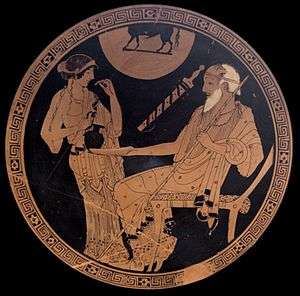
The Greeks also drank kykeon (κυκεών, from κυκάω kykaō, "to shake, to mix"), which was both a beverage and a meal. It was a barley gruel, to which water and herbs were added. In the Iliad, the beverage also contained grated goat cheese.[124] In the Odyssey, Circe adds honey and a magic potion to it.[125] In the Homeric Hymn to Demeter, the goddess refuses red wine but accepts a kykeon made of water, flour, and pennyroyal.[126]
Used as a ritual beverage in the Eleusinian Mysteries, kykeon was also a popular beverage, especially in the countryside: Theophrastus, in his Characters, describes a boorish peasant as having drunk much kykeon and inconveniencing the Assembly with his bad breath.[127] It also had a reputation as a good digestive, and as such, in Peace, Hermes recommends it to the main character who has eaten too much dried fruit.[128]
Cultural beliefs about the role of food
Food played an important part in the Greek mode of thought. Classicist John Wilkins notes that "in the Odyssey for example, good men are distinguished from bad and Greeks from foreigners partly in terms of how and what they ate. Herodotus identified people partly in terms of food and eating".[129]
Up to the 3rd century BC, the frugality imposed by the physical and climatic conditions of the country was held as virtuous. The Greeks did not ignore the pleasures of eating, but valued simplicity. The rural writer Hesiod, as cited above, spoke of his "flesh of a heifer fed in the woods, that has never calved, and of firstling kids" as being the perfect closing to a day. Nonetheless, Chrysippus is quoted as saying that the best meal was a free one.[130]
Culinary and gastronomical research was rejected as a sign of oriental flabbiness: the inhabitants of the Persian Empire were considered decadent due to their luxurious taste, which manifested itself in their cuisine.[131] The Greek authors took pleasure in describing the table of the Achaemenid Great King and his court: Herodotus,[132] Clearchus of Soli,[133] Strabo[134] and Ctesias[135] were unanimous in their descriptions.

In contrast, Greeks as a whole stressed the austerity of their own diet. Plutarch tells how the king of Pontus, eager to try the Spartan "black gruel", bought a Laconian cook; 'but had no sooner tasted it than he found it extremely bad, which the cook observing, told him, "Sir, to make this broth relish, you should have bathed yourself first in the river Eurotas"'.[136] According to Polyaenus,[137] on discovering the dining hall of the Persian royal palace, Alexander the Great mocked their taste and blamed it for their defeat. Pausanias, on discovering the dining habits of the Persian commander Mardonius, equally ridiculed the Persians, "who having so much, came to rob the Greeks of their miserable living".[138]
In consequence of this cult of frugality, and the diminished regard for cuisine it inspired, the kitchen long remained the domain of women, free or enslaved. In the classical period, however, culinary specialists began to enter the written record. Both Aelian[139] and Athenaeus mention the thousand cooks who accompanied Smindyride of Sybaris on his voyage to Athens at the time of Cleisthenes, if only disapprovingly. Plato in Gorgias, mentions "Thearion the cook, Mithaecus the author of a treatise on Sicilian cooking, and Sarambos the wine merchant; three eminent connoisseurs of cake, kitchen and wine."[140] Some chefs also wrote treatises on cuisine.
Over time, more and more Greeks presented themselves as gourmets. From the Hellenistic to the Roman period, the Greeks — at least the rich — no longer appeared to be any more austere than others. The cultivated guests of the feast hosted by Athenaeus in the 2nd or 3rd century devoted a large part of their conversation to wine and gastronomy. They discussed the merits of various wines, vegetables, and meats, mentioning renowned dishes (stuffed cuttlefish, red tuna belly, prawns, lettuce watered with mead) and great cooks such as Soterides, chef to king Nicomedes I of Bithynia (who reigned from the 279 to 250 BC). When his master was inland, he pined for anchovies; Soterides simulated them from carefully carved turnips, oiled, salted and sprinkled with poppy seeds.[141] Suidas (an encyclopaedia from the Byzantine period) mistakenly attributes this exploit to the celebrated Roman gourmet Apicius (1st century BC) —[142] which may be taken as evidence that the Greeks had reached the same level as the Romans.
Specific diets
Vegetarianism
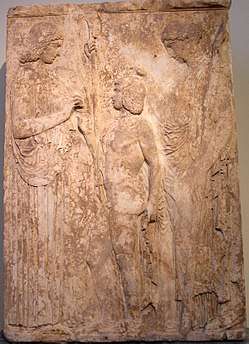
Orphicism and Pythagoreanism, two common ancient Greek religions, suggested a different way of life, based on a concept of purity and thus purification (κάθαρσις katharsis) — a form of asceticism in the original sense: ἄσκησις askēsis initially signifies a ritual, then a specific way of life. Vegetarianism was a central element of Orphicism and of several variants of Pythagoreanism.
Empedocles (5th century BC) justified vegetarianism by a belief in the transmigration of souls: who could guarantee that an animal about to be slaughtered did not house the soul of a human being? However, it can be observed that Empedocles also included plants in this transmigration, thus the same logic should have applied to eating them.[143] Vegetarianism was also a consequence of a dislike for killing: "For Orpheus taught us rights and to refrain from killing".[144]
The information from Pythagoras (6th century BC) is more difficult to define. The Comedic authors such as Aristophanes and Alexis described Pythagoreans as strictly vegetarian, with some of them living on bread and water alone. Other traditions contented themselves with prohibiting the consumption of certain vegetables, such as the broad bean,[145] or of sacred animals such as the white cock or selected animal parts.
It follows that vegetarianism and the idea of ascetic purity were closely associated, and often accompanied by sexual abstinence. In On the eating of flesh, Plutarch (1st–2nd century) elaborated on the barbarism of blood-spilling; inverting the usual terms of debate, he asked the meat-eater to justify his choice.[146]
The Neoplatonic Porphyrius (3rd century) associates in On Abstinence vegetarianism with the Cretan mystery cults, and gives a census of past vegetarians, starting with the semi-mythical Epimenides. For him, the origin of vegetarianism was Demeter's gift of wheat to Triptolemus so that he could teach agriculture to humanity. His three commandments were: "Honour your parents", "Honour the gods with fruit", and "Spare the animals".[147]
Athlete diets
Aelian claims that the first athlete to submit to a formal diet was Ikkos of Tarentum, a victor in the Olympic pentathlon (perhaps in 444 BC).[148] However, Olympic wrestling champion (62nd through 66th Olympiads) Milo of Croton was already said to eat twenty pounds of meat and twenty pounds of bread and to drink eight quarts of wine each day.[149] Before his time, athletes were said to practice ξηροφαγία xērophagía (from ξηρός xēros, "dry"), a diet based on dry foods such as dried figs, fresh cheese and bread.[150] Pythagoras (either the philosopher or a gymnastics master of the same name) was the first to direct athletes to eat meat.[151]
Trainers later enforced some standard diet rules: to be an Olympic victor, "you have to eat according to regulations, keep away from desserts (…); you must not drink cold water nor can you have a drink of wine whenever you want".[152] It seems this diet was primarily based on meat, for Galen (ca. 180 AD) accused athletes of his day of "always gorging themselves on flesh and blood".[153] Pausanias also refers to a "meat diet".[154]
References
- Athenaeus (1928). The Deipnosophistae. v.4. Loeb Classical Library.http://penelope.uchicago.edu/Thayer/E/Roman/Texts/Athenaeus/4A*.html
- The expression originates in Sir Colin Renfrew's The Emergence of Civilisation: The Cyclades and the Aegean in The Third Millennium BC, 1972, p.280.
- https://www.ascsa.edu.gr/uploads/media/hesperia/148493.pdf
- Flacelière, p.205.
- ταγηνίτης, Henry George Liddell, Robert Scott, A Greek-English Lexicon, on Perseus
- ταγηνίας, Henry George Liddell, Robert Scott, A Greek-English Lexicon, on Perseus
- τάγηνον, Henry George Liddell, Robert Scott, A Greek-English Lexicon, on Perseus
- Cratinus, 125, Comicorum Atticorum Fragmenta
- Magnes, 1
- Eugenia Salza Prina Ricotti, Meals and recipes from ancient Greece, J. Paul Getty Museum, 2007, p.111
- Andrew Dalby, Siren feasts: a history of food and gastronomy in Greece, Routledge, 1996, p.91
- Gene A. Spiller, The Mediterranean diets in health and disease, AVI/Van Nostrand Reinhold, 1991, p.34
- σταίτινος, Henry George Liddell, Robert Scott, A Greek-English Lexicon, on Perseus
- σταῖς, Henry George Liddell, Robert Scott, A Greek-English Lexicon, on Perseus
- Atheneaus, The Deipnosophists, 646b, on Perseus
- Andrew Dalby, Food in the ancient world from A to Z, Routledge, 2003, p.71
- Athenaeus and S. Douglas Olson, The Learned Banqueters, Volume VII: Books 13.594b-14, Loeb Classical Library, 2011, pp.277–278
- At the time of Homer and the early tragedies, the term signified the first meal of the day, which was not necessarily frugal: in Iliad 24:124, Achilles's companions slaughter a sheep for breakfast.
- Flacelière, p.206.
- Alexis fgt.214 Kock = Athenaeus 47e.
- Dalby, p.5.
- Dalby, p.15.
- Politics 1323a4.
- Dalby, pp.13–14.
- Flacelière, p.209.
- Sparkes, p.132.
- Aristophanes Knights 413–16; Pollux 6.93.
- Flacelière, p.212.
- Flacelière, p.213.
- Flacelière, p.215.
- Homer (26 February 1898). "The Iliad of Homer: Rendered Into English Prose for the Use of Those who Cannot Read the Original". Longman's, Green – via Google Books.
- Dalby, pp.90–91.
- Wilkins, John M. (2006). Food in the Ancient World. Blackwell. p. 128.
- Dalby, p.22.
- Migeotte, p.62.
- Galen, On the properties of Food 1.10; Dalby p.91: "Much bread was unleavened, but raised bread was well known; baking powder, nitron and wine yeast were both later used as raising agents".
- Sparkes, p.127.
- Flint-Hamilton, p.371
- Sparkes, p.128.
- Flacelière, p.207.
- Aristophanes, Frogs 858 and Wasps 238.
- Dalby, p.91.
- Peace 449.
- Nesbitt, Mark; Summers, Geoffrey (January 1988). "Some Recent Discoveries of Millet (Panicum miliaceum L. and Setaria italica (L.) P. Beauv.) at Excavations in Turkey and Iran". Anatolian Studies. 38 (38): 85–97. doi:10.2307/3642844. JSTOR 3642844. Retrieved 25 February 2019.
- Hesiod (September 2013). Hesiod, the Poems and Fragments, Done Into English Prose. Theclassics Us. pp. fragments S396–423. ISBN 978-1-230-26344-1.
- "The Poems and Fragments - Online Library of Liberty". oll.libertyfund.org.
- Theophrastus; Hort, Arthur (26 February 2019). Enquiry into plants and minor works on odours and weather signs, with an English translation by Sir Arthur Hort, bart. London W. Heinemann – via Internet Archive.
- Flint-Hamilton 1999, p. 375
- Flint-Hamilton, Kimberly B. (1999). "Legumes in Ancient Greece and Rome: Food, Medicine, or Poison?". Hesperia. 68 (3): 371–385. doi:10.2307/148493. JSTOR 148493.
- Homer; Butler (Transl.), Samuel (1898). The Iliad of Homer: Rendered Into English Prose for the Use of Those who Cannot Read the Original. London: Longman's, Green. pp. 217 (line 589).
- Theophrastus; Hort, Arthur (26 February 2019). Enquiry into plants and minor works on odours and weather signs, with an English translation by Sir Arthur Hort, bart. London W. Heinemann – via Internet Archive.
- Theophrastus; Hort, Arthur (26 February 2019). Enquiry into plants and minor works on odours and weather signs, with an English translation by Sir Arthur Hort, bart. London W. Heinemann – via Internet Archive.
- Theophrastus; Hort, Arthur (26 February 2019). Enquiry into plants and minor works on odours and weather signs, with an English translation by Sir Arthur Hort, bart. London W. Heinemann – via Internet Archive.
- Theophrastus; Hort, Arthur (26 February 2019). Enquiry into plants and minor works on odours and weather signs, with an English translation by Sir Arthur Hort, bart. London W. Heinemann – via Internet Archive.
- Theophrastus; Hort, Arthur (26 February 2019). Enquiry into plants and minor works on odours and weather signs, with an English translation by Sir Arthur Hort, bart. London W. Heinemann – via Internet Archive.
- Clifford A. Wright (3 April 2012). Mediterranean Vegetables: A Cook's Compendium of all the Vegetables from The World's Healthiest Cuisine, with More than 200 Re. Harvard Common Press. pp. 414–. ISBN 978-1-55832-591-3.
- "The Poems and Fragments - Online Library of Liberty". oll.libertyfund.org.
- Flint-Hamilton 1999, p. 374
- Flint-Hamilton 1999, p. 373
- "The Poems and Fragments - Online Library of Liberty". oll.libertyfund.org.
- The Frogs 62–63.
- Dalby, p.89.
- Dalby, p.23.
- Dalby, p.90; Flint-Hamilton, p.375.
- Flacelière, p.208.
- Peace 1127–1129. Peace. trans. Eugene O'Neill, Jr. 1938. accessed 23 May 2006.
- Demosthenes, Against Androtion 15.
- Flint-Hamilton 1999, p. 379
- Hesiod. Works and Days 588–93, trans. Hugh G. Evelyn-White 1914. accessed 23 May 2006
- Sparkes 1962, p. 123
- "Athenaeus: Deipnosophists - Book 3". www.attalus.org.
- Life of Lycurgus 12:12.
- Apud Athenaeus 138d, trans. quoted by Dalby, p.126.
- Life of Lycurgus 12:3 and Dicaearchus fgt.72 Wehrli.
- Various History 14:7.
- Peace 374.
- Sparkes, p.123.
- Snyder & Klippel 2003, p. 230
- "Great Online Encyclopaedia of Constantinople". constantinople.ehw.gr.
- "The Internet Classics Archive - The History of Herodotus by Herodotus". classics.mit.edu.
- Dalby, p.67.
- "Athenaeus: Deipnosophists - Book 4". www.attalus.org.
- Davidson 1993, p. 54
- Dalby, Andrew (1995). Siren feasts: a history of food and gastronomy in Greece. Routledge. ISBN 978-0415156578.
- Athenaeus, Epitome 58b.
- Dalby, p.65.
- Athenaeus 151b.
- Owen Powell, trans., Galen: On the properties of food, ISBN 0521812429, 689–696, p. 128-129 ; translator's notes p. 181-182
- Dalby, p. 66
- Dalby, p.66.
- Athenaeus 325f.
- Gilboa, Ayelet; Namdar, Dvory (2015). "Beginnings of South Asian Spice Trade with the Mediterranean". Radiocarbon. 57 (2): 275. doi:10.2458/azu_rc.57.18562.
- "Sappho - SB". chs.harvard.edu.
- Theophrastus; Hort, Arthur (26 February 2019). Enquiry into plants and minor works on odours and weather signs, with an English translation by Sir Arthur Hort, bart. London W. Heinemann – via Internet Archive.
- Kumar, Suresh; Kamboj, Jitpal; Suman; Sharma, Sunil (June 2011). "Overview for Various Aspects of the Health Benefits of Piper Longum Linn. Fruit". Journal of Acupuncture and Meridian Studies. 4 (2): 134–140. doi:10.1016/S2005-2901(11)60020-4. PMID 21704957.
- Maguelonne Toussaint-Samat (25 March 2009). A History of Food. John Wiley & Sons. pp. 443–. ISBN 978-1-4443-0514-2.
- Theophrastus; Hort, Arthur (26 February 2019). Enquiry into plants and minor works on odours and weather signs, with an English translation by Sir Arthur Hort, bart. London W. Heinemann – via Internet Archive.
- Theophrastus (1916). Enquiry into plants and minor works on odours and weather signs, with an English translation by Sir Arthur Hort, bart. 1. London W. Heinemann.
- Homer; Butler (Transl.), Samuel (1898). The Iliad of Homer: Rendered Into English Prose for the Use of Those who Cannot Read the Original. London: Longman's, Green. pp. 182 (Bk 11, line 630).
- Dalby (1996), pp. 109-110.
- Athenaeus. "Deipnosophistae", 325f; Bilabel (1920). English translation from Dalby (2003), p. 79.
- Athenaeus (of Naucratis.); Yonge, C.D. (1854). The Deipnosophists; Or, Banquet of the Learned. v.3. London: H.G. Bohn. Retrieved 25 February 2019.
- Athenaeus 40f–41a commenting on Odyssey 17.208.
- Athenaeus 41a commenting on Iliad 2.753.
- Pindar, fgt.198 B4.
- Σωματώδης sōmatōdēs, Athenaeus 42a.
- Βαρυσταθμότερος barystathmoteros, Athenaeus 42c.
- Κοῦφος kouphos, Athenaeus 42c.
- Κατάξηρος kataxēros, Athenaeus 43a.
- Ὀξύς oxys, Theopompus fgt.229 M. I316 = Athenaeus 43b.
- Τραχὐτερος trakuteros, Athenaeus 43b.
- Οἰνώδης oinōdēs, Athenaeus 42c.
- Antiphanes fgt.179 Kock = Athenaeus 43b–c.
- Athenaeus 44.
- Apud Plutarch, Life of Lycurgus, 9:7–8.
- Athenaeus 28d–e.
- First mention in Dioscorides, Materia Medica 5.34; Dalby, p.150.
- Various History 12:31.
- Athenaeus 31d.
- E.g. Menander, Samia 394.
- Various History, 13:6.
- Various History, 2:38.
- Dalby, p.88–9.
- Iliad 15:638–641.
- Odyssey 10:234.
- Homeric hymn to Demeter 208.
- Characters 4:2–3.
- Peace 712.
- Wilkins, "Introduction: part II" in Wilkins, Harvey and Dobson, p.3.
- Apud Athenaeus 8c–d.
- For a comparison of Persian and Greek cuisine, see Briant, pp.297–306.
- Herodotus 1:133.
- Apud Athenaeus 539b.
- Description of Greece 15:3,22.
- Ctesias fgt.96 M = Athenaeus 67a.
- Plutarch, Life of Lycurgus 12:13, trans. John Dryden. Accessed 26 May 2006.
- Stratagems, 4:3,32.
- Stratagems 4:82.
- Various History 22:24.
- Gorgias 518b.
- Euphro Comicus fgt.11 Kock = Athenaeus 7d–f.
- Suidas s.v. ἀφὐα.
- Dodds, pp.154–5.
- Aristophanes, Frogs 1032. Trans. Matthew Dillon, accessed 2 June 2006.
- Flint-Hamilton, pp.379–380.
- Moralia 12:68.
- On Abstinence 4.62.
- Various History (11:3).
- Athenaeus 412f.
- Athenaeus 205.
- Diogenes Laërtius 8:12.
- Epictetus, Discourses 15:2–5, trans. W.E. Sweet.
- Exhortation for Medicine 9, trans. S.G. Miller.
- Pausanias 6:7.10.
Works cited
- Briant, P. Histoire de l'Empire perse de Cyrus à Alexandre. Paris: Fayard, 1996. ISBN 2-213-59667-0, translated in English as From Cyrus to Alexander: A History of the Persian Empire. Winona Lake, Ind.: Eisenbrauns, 2002 ISBN 1-57506-031-0
- Dalby, A. Siren Feasts: A History of Food and Gastronomy in Greece. London: Routledge, 1996. ISBN 0-415-15657-2
- Davidson, James (1993). "Fish, Sex and Revolution in Athens". The Classical Quarterly. 43 (1): 53. doi:10.1017/S0009838800044177.CS1 maint: ref=harv (link)
- Dodds, E.R. "The Greek Shamans and the Origins of Puritanism ", The Greek and the Irrational (Sather Classical Lectures). Berkeley: University of California Press, 1962 (1st edn 1959).
- Flacelière R. La Vie quotidienne en Grèce au temps de Périclès. Paris: Hachette, 1988 (1st edn. 1959) ISBN 2-01-005966-2, translated in English as Daily Life in Greece at the Time of Pericles. London: Phoenix Press, 2002 ISBN 1-84212-507-9
- Flint-Hamilton, Kimberly B. (July 1999). "Legumes in Ancient Greece and Rome: Food, Medicine, or Poison?". Hesperia. 68 (3): 371–385. doi:10.2307/148493. JSTOR 148493.CS1 maint: ref=harv (link)
- Migeotte, L., L'Économie des cités grecques. Paris: Ellipses, 2002 ISBN 2-7298-0849-3 (in French)
- Snyder, Lynn M.; Klippel, Walter E. (2003). "From Lerna to Kastro: further thoughts on dogs as food in ancient Greece: perceptions, prejudices, and reinvestigations". British School at Athens Studies. 9: 221–231. JSTOR 40960350.CS1 maint: ref=harv (link)
- Sparkes, B. A. (1962). "The Greek Kitchen". The Journal of Hellenic Studies. 82: 121–137. doi:10.2307/628548. JSTOR 628548.CS1 maint: ref=harv (link)
- Wilkins, J., Harvey, D. and Dobson, M. Food in Antiquity. Exeter: University of Exeter Press, 1995. ISBN 0-85989-418-5
Further reading
- (in French) Amouretti, M.-Cl. Le Pain et l'huile dans la Grèce antique. De l'araire au moulin. Paris: Belles Lettres, 1989.
- (in French) Delatte, A. Le Cycéon, breuvage rituel des mystères d'Éleusis. Paris: Belles Lettres, 1955.
- Detienne, M. and Vernant, J.-P. (trans. Wissing, P.). The Cuisine of Sacrifice Among the Greeks. Chicago: The University of Chicago Press, 1989 (1st edn. 1979) ISBN 0-226-14353-8
- Davidson, James. Courtesans and Fishcakes: The Consuming Passions of Classical Athens. Fontana Press. 1998. ISBN 978-0006863434
External links
- (in French) "Végétarisme, au commencement…" (French language article on the origins of vegetarianism)
- A Taste of the Ancient World (University of Michigan)
- Ancient Greek Recipes and posts about Ancient Greek Cuisine
